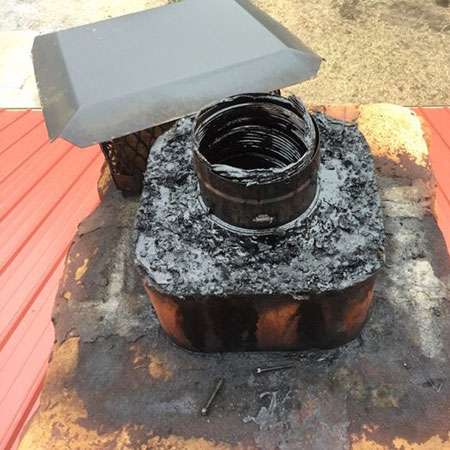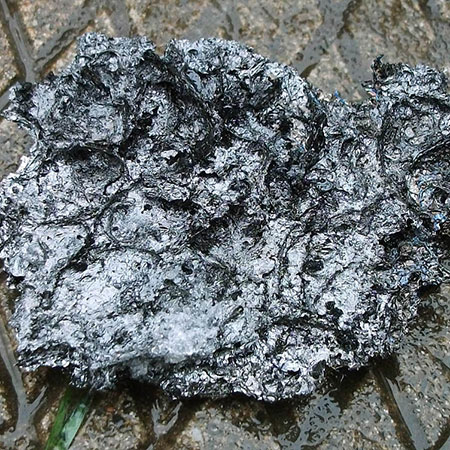What is Glazed Creosote?
Creosote is combustion material from wood fires that is found in chimneys in three forms, and glazed creosote is the most difficult type to remove from a chimney liner. Tar and soot are also combustion byproducts, and they are mixed in with the creosote. Whether glazed creosote or another form is in your chimney, it is highly flammable.
Two risks are created by creosote. First, chimney fires can be ignited when glowing embers attach to the creosote. Chimney fires are highly intense and can destroy flue linings, leading to house fires. Secondly, a buildup of creosote can cause a chimney obstruction. When combustion gases can’t exit through the chimney the way they are supposed to, life-threatening toxic gases can enter the home.
What Causes Creosote?
 Creosote is a combustion byproduct of wood fires. If you have an efficient fire using only seasoned or low-moisture firewood, the amount of creosote created is minimal. However, smoldering fires lead to less complete combustion, which increases the amount of creosote produced. What dirties up a chimney with creosote most quickly is green wood, which should actually never be used as firewood. Wood is always supposed to go through a process of drying out before being tossed in a fire. After six months to a year or more, firewood is ready to burn and is referred to as “seasoned” firewood.
Creosote is a combustion byproduct of wood fires. If you have an efficient fire using only seasoned or low-moisture firewood, the amount of creosote created is minimal. However, smoldering fires lead to less complete combustion, which increases the amount of creosote produced. What dirties up a chimney with creosote most quickly is green wood, which should actually never be used as firewood. Wood is always supposed to go through a process of drying out before being tossed in a fire. After six months to a year or more, firewood is ready to burn and is referred to as “seasoned” firewood.
The Three Forms of Creosote
When a professional chimney technician performs annual chimney inspections, he or she will usually let you know how much creosote is in your chimney and what type it is. The following are the three forms of creosote:
Level 1 – The easiest kind of creosote to remove is Level 1 creosote. A professional chimney brush is all that is required to clean this type of creosote from the chimney.
Level 2 – Creosote can also appear as hard, shiny, black flakes. Level 2 creosote can be difficult to remove. It’s not unusual for powerful tools such as rotary loops or drills to be used for Level 2 creosote removal.
Level 3 – The most hazardous and difficult-to-remove creosote is Level 3 creosote, also referred to as “glazed creosote.” It has the appearance of tar being poured down the chimney, and the tar-like substance becomes hardened. Chimney fires are always dangerous, but glazed creosote creates a greater threat because it can keep a chimney fire fueled for a very long time.
Glazed creosote occurs in several ways. It can show up when a layer of creosote accumulates rapidly before the previous layers of creosote have had a chance to dry. Burning green wood can also cause glazed creosote to form in your chimney. Using an improperly sized flue for a heating appliance is another way glazed creosote forms.
Removal of Glazed Creosote
 Traditional chimney tools and brushes are inadequate to remove Level 3 creosote. Special chemicals or acids can sometimes be used, which is an extremely time-consuming process. Sometimes the only solution to glazed creosote is to have the chimney relined.
Traditional chimney tools and brushes are inadequate to remove Level 3 creosote. Special chemicals or acids can sometimes be used, which is an extremely time-consuming process. Sometimes the only solution to glazed creosote is to have the chimney relined.
Contact Dubuque Fireplace & Patio for Chimney Services
Do you have glazed creosote in your chimney or are you concerned that you may have Level 3 creosote? Contact us at Dubuque Fireplace & Patio for chimney cleaning and every other type of chimney maintenance and repair, including chimney inspections, chimney crown rebuilds, chimney leaks, and chimney rebuilding. Contact information is below.
Dubuque Fireplace & Patio
925 Century Drive, Dubuque, Iowa
Phone – (563) 582-5156
Chimney Specialists Inc.
869 Main Street, Highland, WI
Phone – (608) 929-4887 / Toll Free (800) 395-6660


 (563) 582-5156
(563) 582-5156


